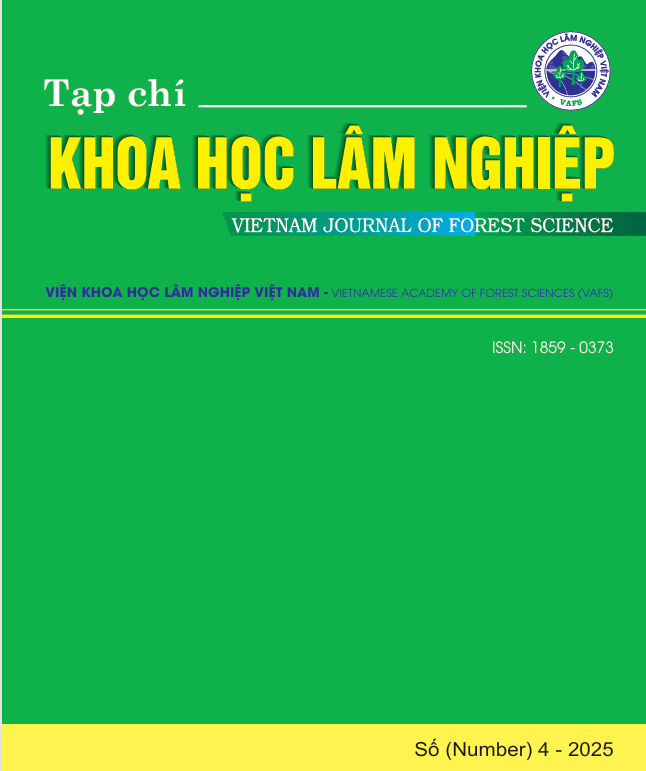GROWTH CHARACTERISTICS OF TETRAPLOID F2 ACACIA HYBRIDS IN A CLONAL TRIAL AT BA VI
DOI:
https://doi.org/10.70169/VJFS.1078Keywords:
Diploid, growth, polypoid breeding, tetraploid, F2 acacia hybridAbstract
The study evaluated and compared the growth performance of 41 diploid (2n) and 14 tetraploid (4n) F2 hybrid acacia clones at 4 years of age in Ba Vi. The growth traits assessed included diameter at breast height (D1.3), total tree height (Hvn), stem volume (V), and morphological characteristics such as stem straightness (St) and an overall stem quality index (Icl). The results showed that tetraploid clones exhibited lower growth compared to diploid clones in most parameters (P<0.05): D1.3 (5.74cm vs. 6.53cm), Hvn (7.44m vs. 8.08m), and stem volume (14.06 dm³/tree vs. 17.39 dm³/tree). The average survival rate of tetraploid clones was 56.96%, slightly lower than that of diploid clones (57.32%). However, tetraploid trees had a higher overall stem quality index (3.96 vs. 3.80), and several tetraploid clones demonstrated good growth (P < 0.05), indicating potential for improving planting stock quality through selection of superior tetraploid lines.
References
1. Baker, R. L., Brock, G. L., Newsome, E. L., & Zhao, M., 2024. Polyploidy and the evolution of phenotypic integration: Network analysis reveals relationships among anatomy, morphology, and physiology. Applications in Plant Sciences, 12(4), e11605. https://doi.org/https://doi.org/10.1002/aps3.11605
2. Beck, S. L., Visser, G., Dunlop, R. W., & Hare, P. D., 2005. A comparison of direct (flow cytometry) and indirect (stomatal guard cell lengths and chloroplast numbers) techniques as a measure of ploidy in black wattle, Acacia mearnsii (de Wild). South African Journal of Botany, 71(3), 354-358. https://doi.org/https://doi.org/10.1016/S0254-6299(15)30109-5
3. Chen, T., Sheng, Y., Hao, Z., Long, X., Fu, F., Liu, Y., Tang, Z., Ali, A., Peng, Y., Liu, Y., Lu, L., Hu, X., Shi, J., & Chen, J., 2021. Transcriptome and proteome analysis suggest enhanced photosynthesis in tetraploid Liriodendron sino-americanum. Tree Physiology, 41(10), 1953-1971. https://doi.org/10.1093/treephys/tpab039
4. Chen, Z. J., & Birchler, J. A., 2013. Polyploid and hybrid genomics. John Wiley & Sons.
5. da Silva Souza, T., Muniz, F. R., Techio, V. H., Missiaggia, A. A., & Ramalho, M. A. P., 2022. Potential use of polyploid eucalypt in forestry. Industrial Crops and Products, 177, 114464. https://doi.org/https://doi.org/10.1016/j.indcrop.2021.114464
6. Dhooghe, E., Van Laere, K., Eeckhaut, T., Leus, L., & Van Huylenbroeck, J., 2011. Mitotic chromosome doubling of plant tissues in vitro. Plant Cell, Tissue and Organ Culture (PCTOC), 104(3), 359-373. https://doi.org/10.1007/s11240-010-9786-5
7. Griffin, A. R., Chi, N. Q., Harbard, J. L., Son, D. H., Harwood, C. E., Price, A., Vuong, T. D., Koutoulis, A., & Thinh, H. H., 2015. Breeding polyploid varieties of tropical acacias: progress and prospects. Southern Forests, 77(1), 41-50. https://doi.org/10.2989/20702620.2014.999303
8. Huang, X.-Y., Shang, J., Zhong, Y.-H., Li, D.-L., Song, L.-J., & Wang, J., 2022. Disaggregation of Ploidy, Gender, and Genotype Effects on Wood and Fiber Traits in a Diploid and Triploid Hybrid Poplar Family [Original Research]. Frontiers in Plant Science, Volume 13 - 2022. https://doi.org/10.3389/fpls.2022.866296
9. Kang, X., & Wei, H., 2022. Breeding polyploid Populus: progress and perspective. Forestry Research, 2(1). https://doi.org/10.48130/FR-2022-0004
10. Le, S., Griffin, R. A., Harwood, C. E., Vaillancourt, R. E., Harbard, J. L., Price, A., Nghiem, C. Q., Koutoulis, A., & Nguyen, K. D., 2021. Breeding Polyploid Varieties of Acacia: Reproductive and Early Growth Characteristics of the Allotetraploid Hybrid (Acacia mangium × A. auriculiformis) in Comparison with Diploid Progenitors. Forests, 12(6), 778. https://www.mdpi.com/1999-4907/12/6/778
11. Longui, E. L., Custódio, G. H., Amorim, E. P., Silva Júnior, F. G. d., Oda, S., & Souza, I. C. G., 2021. Differences in wood properties among Eucalyptus grandis and Eucalyptus grandis x Eucalyptus urophylla with different degrees of ploidy. Research, Society and Development, 10(16), e395101624035. https://doi.org/10.33448/rsd-v10i16.24035
12. Song, Q., & Chen, Z. J., 2015. Epigenetic and developmental regulation in plant polyploids. Curr Opin Plant Biol, 24, 101-109. https://doi.org/10.1016/j.pbi.2015.02.007
13. Trojak-Goluch, A., Kawka-Lipińska, M., Wielgusz, K., & Praczyk, M., 2021. Polyploidy in Industrial Crops: Applications and Perspectives in Plant Breeding. Agronomy, 11(12), 2574. https://www.mdpi.com/2073-4395/11/12/2574
14. Wang, L., Li, Y., Li, H., Li, S., Song, J., & Guan, W., 2025. Comparison of the morphological and physiological characteristics of diploid and tetraploid Luculia pinceana Hook. BMC Plant Biol, 25(1), 536. https://doi.org/10.1186/s12870-025-06568-w
15. Xue, H., Zhang, B., Tian, J.-R., Chen, M.-M., Zhang, Y.-Y., Zhang, Z.-H., & Ma, Y., 2017. Comparison of the morphology, growth and development of diploid and autotetraploid ‘Hanfu’ apple trees. Scientia Horticulturae, 225, 277-285. https://doi.org/https://doi.org/10.1016/j.scienta.2017.06.059
16. Zhang, X., Zheng, Z., Wang, J., Li, Y., Gao, Y., Li, L., Pang, Y., & Bian, F., 2024. In vitro induction of tetraploids and their phenotypic and transcriptome analysis in Glehnia littoralis. Bmc Plant Biology, 24(1), 439. https://doi.org/10.1186/s12870-024-05154-w









